Level 5 Project: Detailed Learning Contract & Project Report Guide
VerifiedAdded on 2023/04/21
|16
|4078
|117
Project
AI Summary
This Level 5 project solution provides a detailed learning contract and project report. The learning contract outlines the student's aims, learning outcomes, justification, chosen methodologies (PMBOK), a project timetable, and evidence of accomplishment. The project report covers the project's context and background, followed by a literature review of project management models such as Waterfall, Agile, Hybrid, and Scrum. The report emphasizes the importance of project planning, execution, and evaluation, referencing various sources to support its findings. The document concludes with appendices including process groups, implementation phases, and evaluations of project management offices, offering a comprehensive overview of the project management process. Desklib provides access to this and many other solved assignments for students.
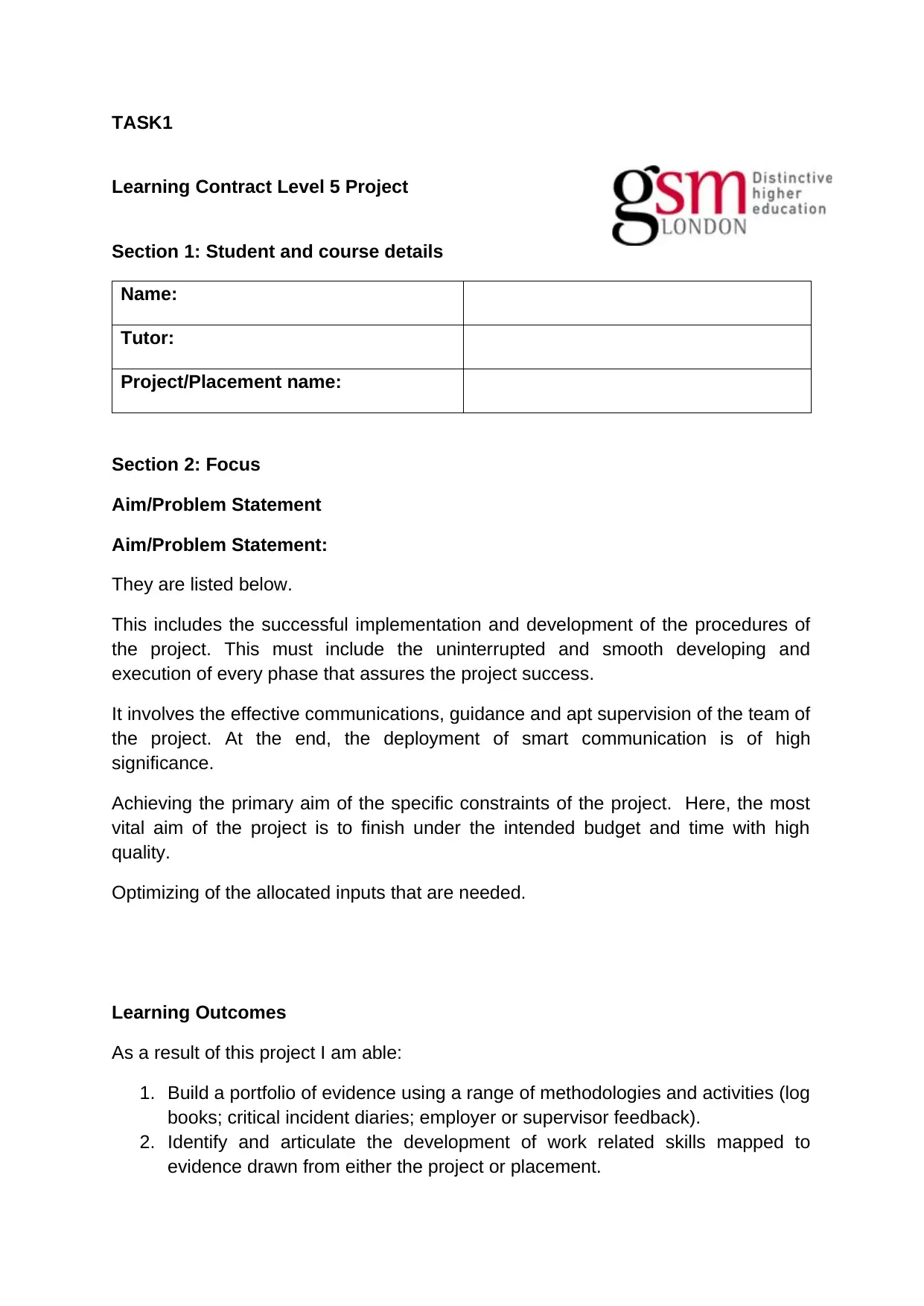
TASK1
Learning Contract Level 5 Project
Section 1: Student and course details
Name:
Tutor:
Project/Placement name:
Section 2: Focus
Aim/Problem Statement
Aim/Problem Statement:
They are listed below.
This includes the successful implementation and development of the procedures of
the project. This must include the uninterrupted and smooth developing and
execution of every phase that assures the project success.
It involves the effective communications, guidance and apt supervision of the team of
the project. At the end, the deployment of smart communication is of high
significance.
Achieving the primary aim of the specific constraints of the project. Here, the most
vital aim of the project is to finish under the intended budget and time with high
quality.
Optimizing of the allocated inputs that are needed.
Learning Outcomes
As a result of this project I am able:
1. Build a portfolio of evidence using a range of methodologies and activities (log
books; critical incident diaries; employer or supervisor feedback).
2. Identify and articulate the development of work related skills mapped to
evidence drawn from either the project or placement.
Learning Contract Level 5 Project
Section 1: Student and course details
Name:
Tutor:
Project/Placement name:
Section 2: Focus
Aim/Problem Statement
Aim/Problem Statement:
They are listed below.
This includes the successful implementation and development of the procedures of
the project. This must include the uninterrupted and smooth developing and
execution of every phase that assures the project success.
It involves the effective communications, guidance and apt supervision of the team of
the project. At the end, the deployment of smart communication is of high
significance.
Achieving the primary aim of the specific constraints of the project. Here, the most
vital aim of the project is to finish under the intended budget and time with high
quality.
Optimizing of the allocated inputs that are needed.
Learning Outcomes
As a result of this project I am able:
1. Build a portfolio of evidence using a range of methodologies and activities (log
books; critical incident diaries; employer or supervisor feedback).
2. Identify and articulate the development of work related skills mapped to
evidence drawn from either the project or placement.
Paraphrase This Document
Need a fresh take? Get an instant paraphrase of this document with our AI Paraphraser
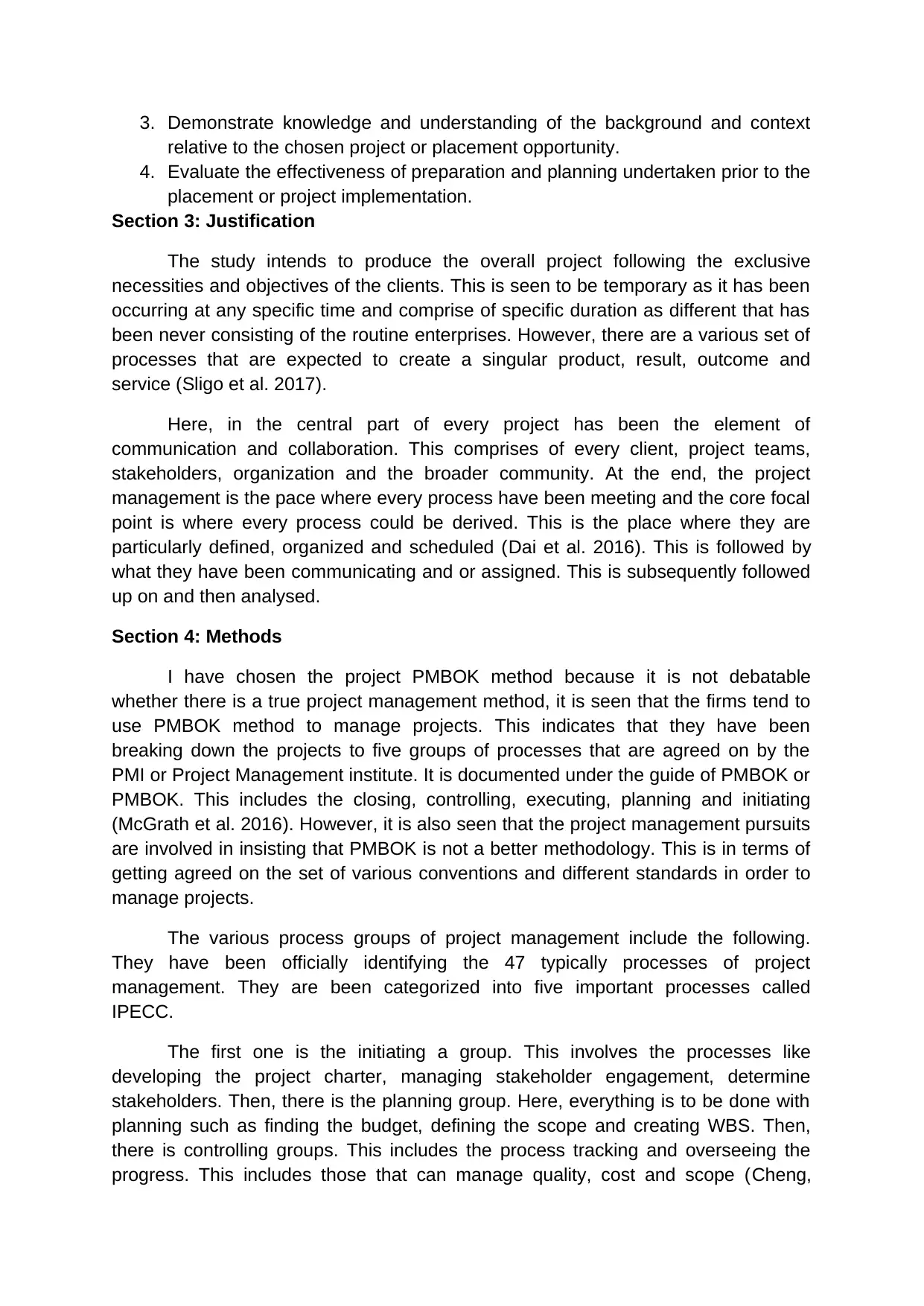
3. Demonstrate knowledge and understanding of the background and context
relative to the chosen project or placement opportunity.
4. Evaluate the effectiveness of preparation and planning undertaken prior to the
placement or project implementation.
Section 3: Justification
The study intends to produce the overall project following the exclusive
necessities and objectives of the clients. This is seen to be temporary as it has been
occurring at any specific time and comprise of specific duration as different that has
been never consisting of the routine enterprises. However, there are a various set of
processes that are expected to create a singular product, result, outcome and
service (Sligo et al. 2017).
Here, in the central part of every project has been the element of
communication and collaboration. This comprises of every client, project teams,
stakeholders, organization and the broader community. At the end, the project
management is the pace where every process have been meeting and the core focal
point is where every process could be derived. This is the place where they are
particularly defined, organized and scheduled (Dai et al. 2016). This is followed by
what they have been communicating and or assigned. This is subsequently followed
up on and then analysed.
Section 4: Methods
I have chosen the project PMBOK method because it is not debatable
whether there is a true project management method, it is seen that the firms tend to
use PMBOK method to manage projects. This indicates that they have been
breaking down the projects to five groups of processes that are agreed on by the
PMI or Project Management institute. It is documented under the guide of PMBOK or
PMBOK. This includes the closing, controlling, executing, planning and initiating
(McGrath et al. 2016). However, it is also seen that the project management pursuits
are involved in insisting that PMBOK is not a better methodology. This is in terms of
getting agreed on the set of various conventions and different standards in order to
manage projects.
The various process groups of project management include the following.
They have been officially identifying the 47 typically processes of project
management. They are been categorized into five important processes called
IPECC.
The first one is the initiating a group. This involves the processes like
developing the project charter, managing stakeholder engagement, determine
stakeholders. Then, there is the planning group. Here, everything is to be done with
planning such as finding the budget, defining the scope and creating WBS. Then,
there is controlling groups. This includes the process tracking and overseeing the
progress. This includes those that can manage quality, cost and scope (Cheng,
relative to the chosen project or placement opportunity.
4. Evaluate the effectiveness of preparation and planning undertaken prior to the
placement or project implementation.
Section 3: Justification
The study intends to produce the overall project following the exclusive
necessities and objectives of the clients. This is seen to be temporary as it has been
occurring at any specific time and comprise of specific duration as different that has
been never consisting of the routine enterprises. However, there are a various set of
processes that are expected to create a singular product, result, outcome and
service (Sligo et al. 2017).
Here, in the central part of every project has been the element of
communication and collaboration. This comprises of every client, project teams,
stakeholders, organization and the broader community. At the end, the project
management is the pace where every process have been meeting and the core focal
point is where every process could be derived. This is the place where they are
particularly defined, organized and scheduled (Dai et al. 2016). This is followed by
what they have been communicating and or assigned. This is subsequently followed
up on and then analysed.
Section 4: Methods
I have chosen the project PMBOK method because it is not debatable
whether there is a true project management method, it is seen that the firms tend to
use PMBOK method to manage projects. This indicates that they have been
breaking down the projects to five groups of processes that are agreed on by the
PMI or Project Management institute. It is documented under the guide of PMBOK or
PMBOK. This includes the closing, controlling, executing, planning and initiating
(McGrath et al. 2016). However, it is also seen that the project management pursuits
are involved in insisting that PMBOK is not a better methodology. This is in terms of
getting agreed on the set of various conventions and different standards in order to
manage projects.
The various process groups of project management include the following.
They have been officially identifying the 47 typically processes of project
management. They are been categorized into five important processes called
IPECC.
The first one is the initiating a group. This involves the processes like
developing the project charter, managing stakeholder engagement, determine
stakeholders. Then, there is the planning group. Here, everything is to be done with
planning such as finding the budget, defining the scope and creating WBS. Then,
there is controlling groups. This includes the process tracking and overseeing the
progress. This includes those that can manage quality, cost and scope (Cheng,
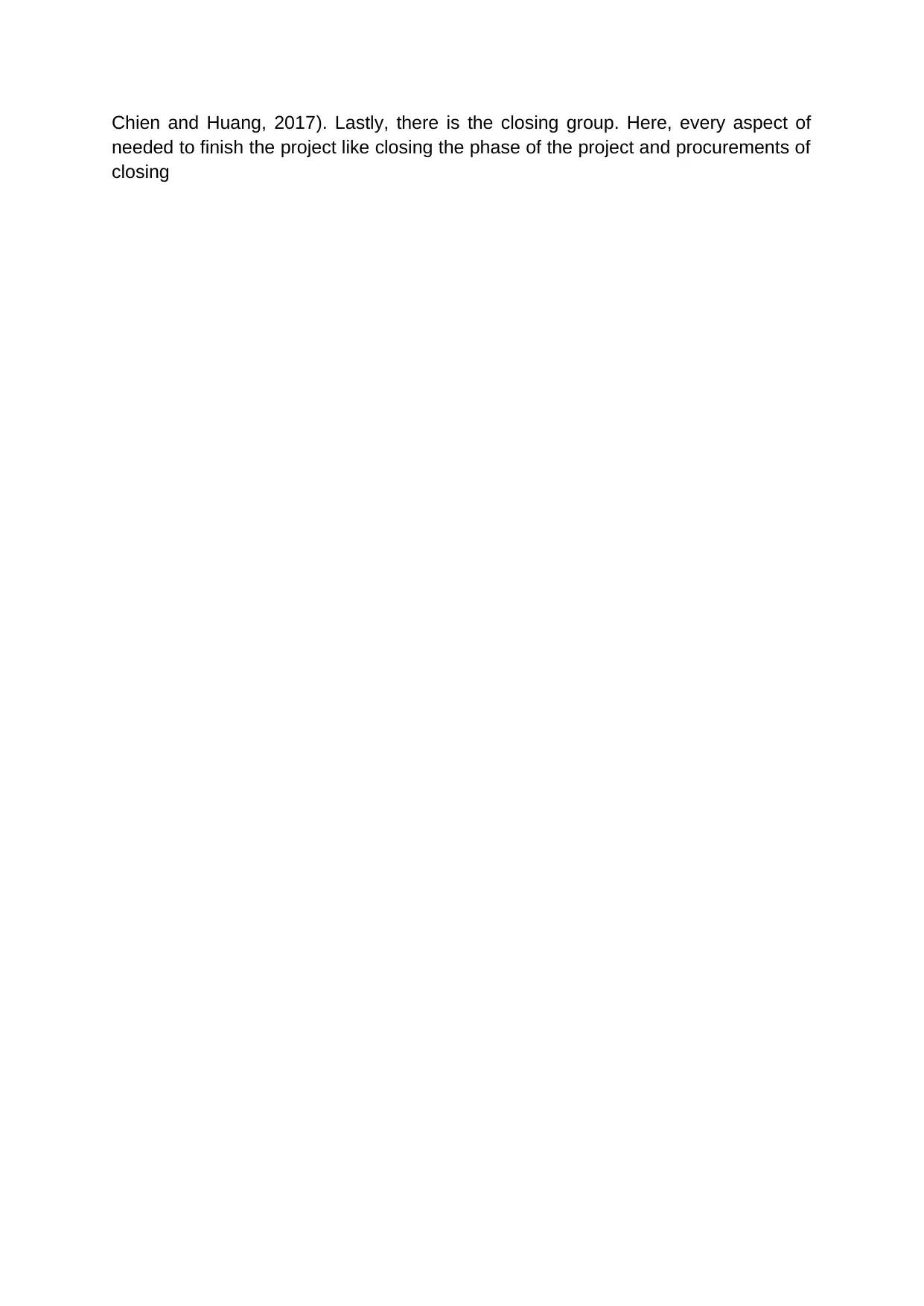
Chien and Huang, 2017). Lastly, there is the closing group. Here, every aspect of
needed to finish the project like closing the phase of the project and procurements of
closing
needed to finish the project like closing the phase of the project and procurements of
closing
⊘ This is a preview!⊘
Do you want full access?
Subscribe today to unlock all pages.

Trusted by 1+ million students worldwide
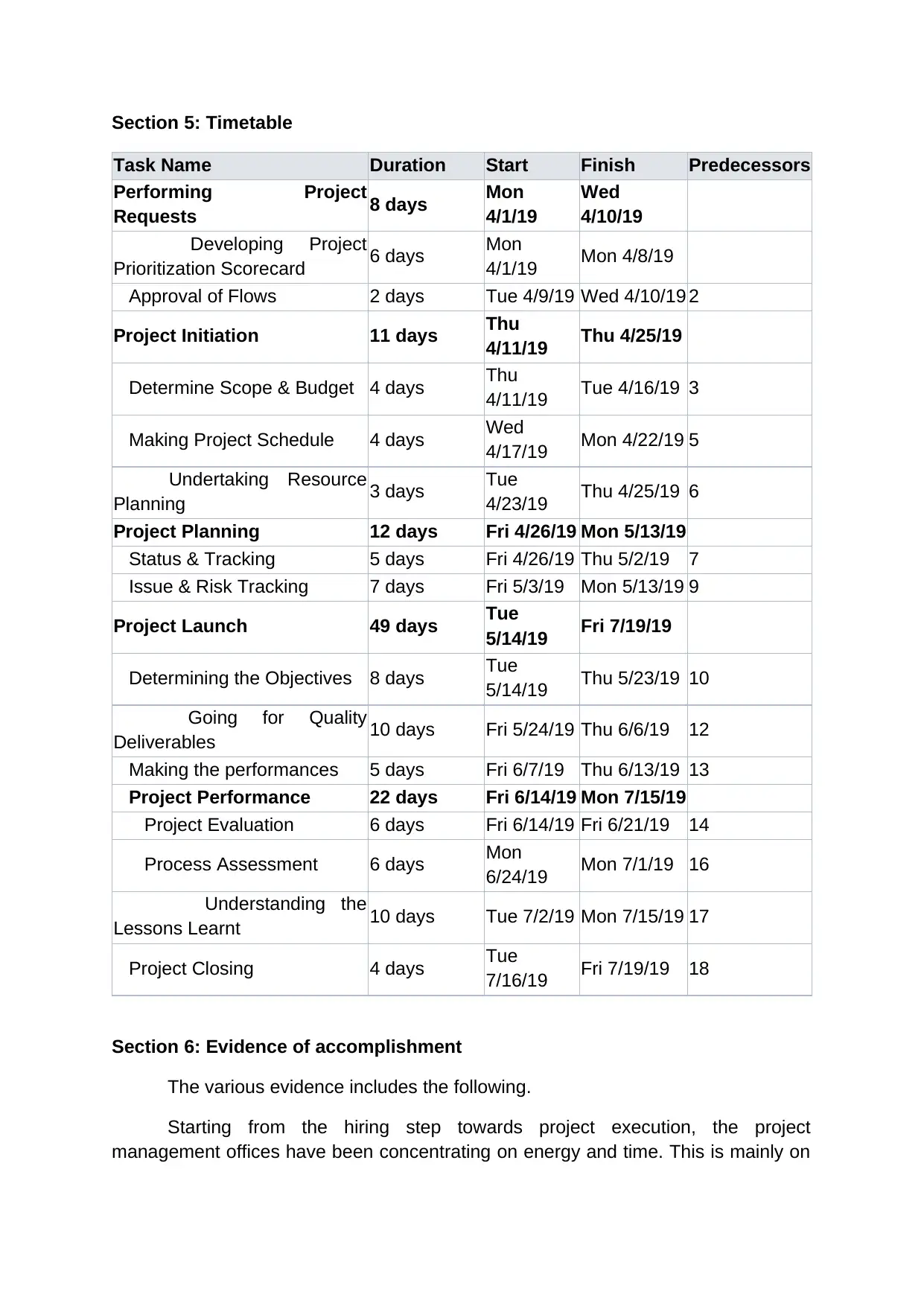
Section 5: Timetable
Task Name Duration Start Finish Predecessors
Performing Project
Requests 8 days Mon
4/1/19
Wed
4/10/19
Developing Project
Prioritization Scorecard 6 days Mon
4/1/19 Mon 4/8/19
Approval of Flows 2 days Tue 4/9/19 Wed 4/10/19 2
Project Initiation 11 days Thu
4/11/19 Thu 4/25/19
Determine Scope & Budget 4 days Thu
4/11/19 Tue 4/16/19 3
Making Project Schedule 4 days Wed
4/17/19 Mon 4/22/19 5
Undertaking Resource
Planning 3 days Tue
4/23/19 Thu 4/25/19 6
Project Planning 12 days Fri 4/26/19 Mon 5/13/19
Status & Tracking 5 days Fri 4/26/19 Thu 5/2/19 7
Issue & Risk Tracking 7 days Fri 5/3/19 Mon 5/13/19 9
Project Launch 49 days Tue
5/14/19 Fri 7/19/19
Determining the Objectives 8 days Tue
5/14/19 Thu 5/23/19 10
Going for Quality
Deliverables 10 days Fri 5/24/19 Thu 6/6/19 12
Making the performances 5 days Fri 6/7/19 Thu 6/13/19 13
Project Performance 22 days Fri 6/14/19 Mon 7/15/19
Project Evaluation 6 days Fri 6/14/19 Fri 6/21/19 14
Process Assessment 6 days Mon
6/24/19 Mon 7/1/19 16
Understanding the
Lessons Learnt 10 days Tue 7/2/19 Mon 7/15/19 17
Project Closing 4 days Tue
7/16/19 Fri 7/19/19 18
Section 6: Evidence of accomplishment
The various evidence includes the following.
Starting from the hiring step towards project execution, the project
management offices have been concentrating on energy and time. This is mainly on
Task Name Duration Start Finish Predecessors
Performing Project
Requests 8 days Mon
4/1/19
Wed
4/10/19
Developing Project
Prioritization Scorecard 6 days Mon
4/1/19 Mon 4/8/19
Approval of Flows 2 days Tue 4/9/19 Wed 4/10/19 2
Project Initiation 11 days Thu
4/11/19 Thu 4/25/19
Determine Scope & Budget 4 days Thu
4/11/19 Tue 4/16/19 3
Making Project Schedule 4 days Wed
4/17/19 Mon 4/22/19 5
Undertaking Resource
Planning 3 days Tue
4/23/19 Thu 4/25/19 6
Project Planning 12 days Fri 4/26/19 Mon 5/13/19
Status & Tracking 5 days Fri 4/26/19 Thu 5/2/19 7
Issue & Risk Tracking 7 days Fri 5/3/19 Mon 5/13/19 9
Project Launch 49 days Tue
5/14/19 Fri 7/19/19
Determining the Objectives 8 days Tue
5/14/19 Thu 5/23/19 10
Going for Quality
Deliverables 10 days Fri 5/24/19 Thu 6/6/19 12
Making the performances 5 days Fri 6/7/19 Thu 6/13/19 13
Project Performance 22 days Fri 6/14/19 Mon 7/15/19
Project Evaluation 6 days Fri 6/14/19 Fri 6/21/19 14
Process Assessment 6 days Mon
6/24/19 Mon 7/1/19 16
Understanding the
Lessons Learnt 10 days Tue 7/2/19 Mon 7/15/19 17
Project Closing 4 days Tue
7/16/19 Fri 7/19/19 18
Section 6: Evidence of accomplishment
The various evidence includes the following.
Starting from the hiring step towards project execution, the project
management offices have been concentrating on energy and time. This is mainly on
Paraphrase This Document
Need a fresh take? Get an instant paraphrase of this document with our AI Paraphraser
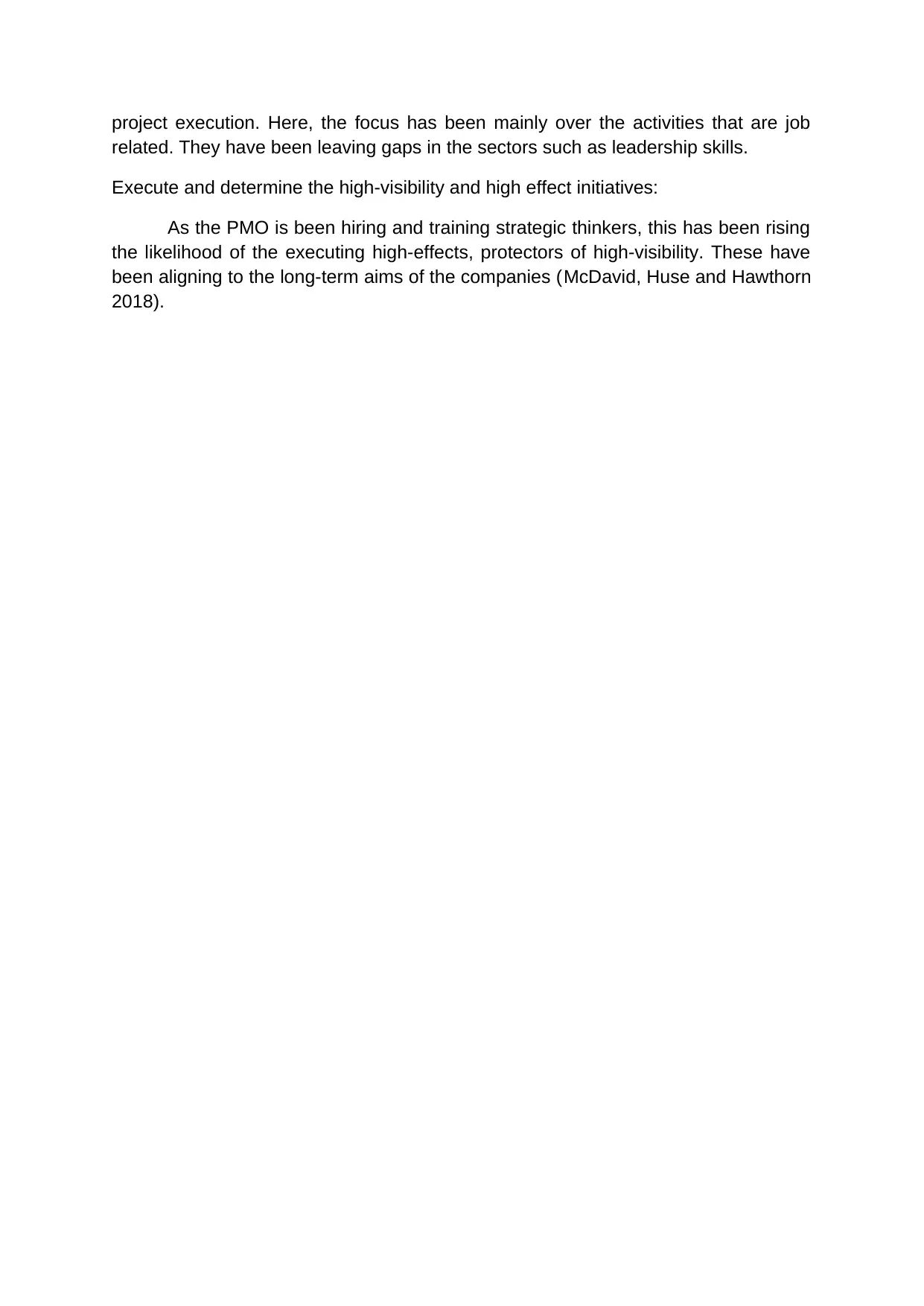
project execution. Here, the focus has been mainly over the activities that are job
related. They have been leaving gaps in the sectors such as leadership skills.
Execute and determine the high-visibility and high effect initiatives:
As the PMO is been hiring and training strategic thinkers, this has been rising
the likelihood of the executing high-effects, protectors of high-visibility. These have
been aligning to the long-term aims of the companies (McDavid, Huse and Hawthorn
2018).
related. They have been leaving gaps in the sectors such as leadership skills.
Execute and determine the high-visibility and high effect initiatives:
As the PMO is been hiring and training strategic thinkers, this has been rising
the likelihood of the executing high-effects, protectors of high-visibility. These have
been aligning to the long-term aims of the companies (McDavid, Huse and Hawthorn
2018).
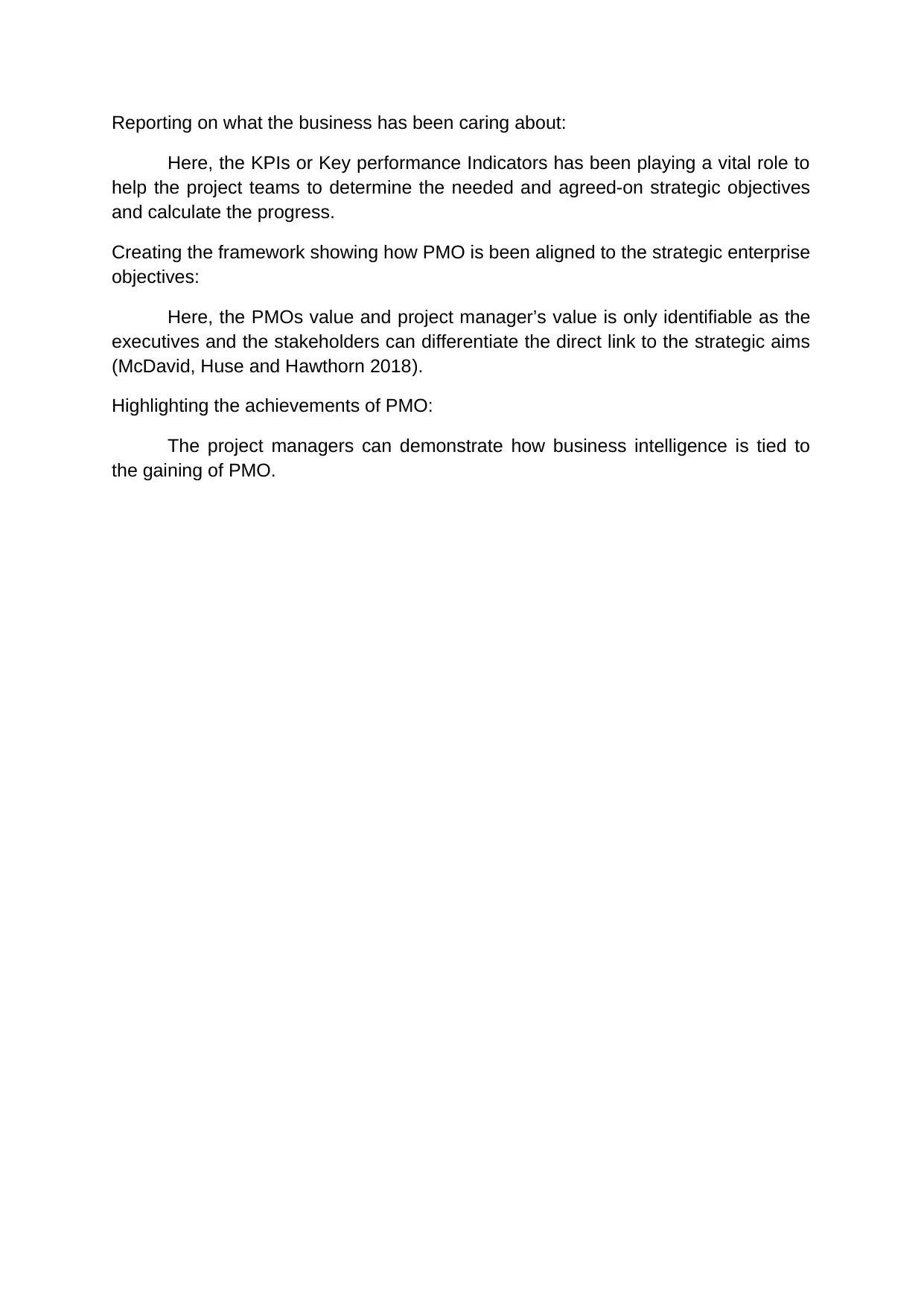
Reporting on what the business has been caring about:
Here, the KPIs or Key performance Indicators has been playing a vital role to
help the project teams to determine the needed and agreed-on strategic objectives
and calculate the progress.
Creating the framework showing how PMO is been aligned to the strategic enterprise
objectives:
Here, the PMOs value and project manager’s value is only identifiable as the
executives and the stakeholders can differentiate the direct link to the strategic aims
(McDavid, Huse and Hawthorn 2018).
Highlighting the achievements of PMO:
The project managers can demonstrate how business intelligence is tied to
the gaining of PMO.
Here, the KPIs or Key performance Indicators has been playing a vital role to
help the project teams to determine the needed and agreed-on strategic objectives
and calculate the progress.
Creating the framework showing how PMO is been aligned to the strategic enterprise
objectives:
Here, the PMOs value and project manager’s value is only identifiable as the
executives and the stakeholders can differentiate the direct link to the strategic aims
(McDavid, Huse and Hawthorn 2018).
Highlighting the achievements of PMO:
The project managers can demonstrate how business intelligence is tied to
the gaining of PMO.
⊘ This is a preview!⊘
Do you want full access?
Subscribe today to unlock all pages.

Trusted by 1+ million students worldwide
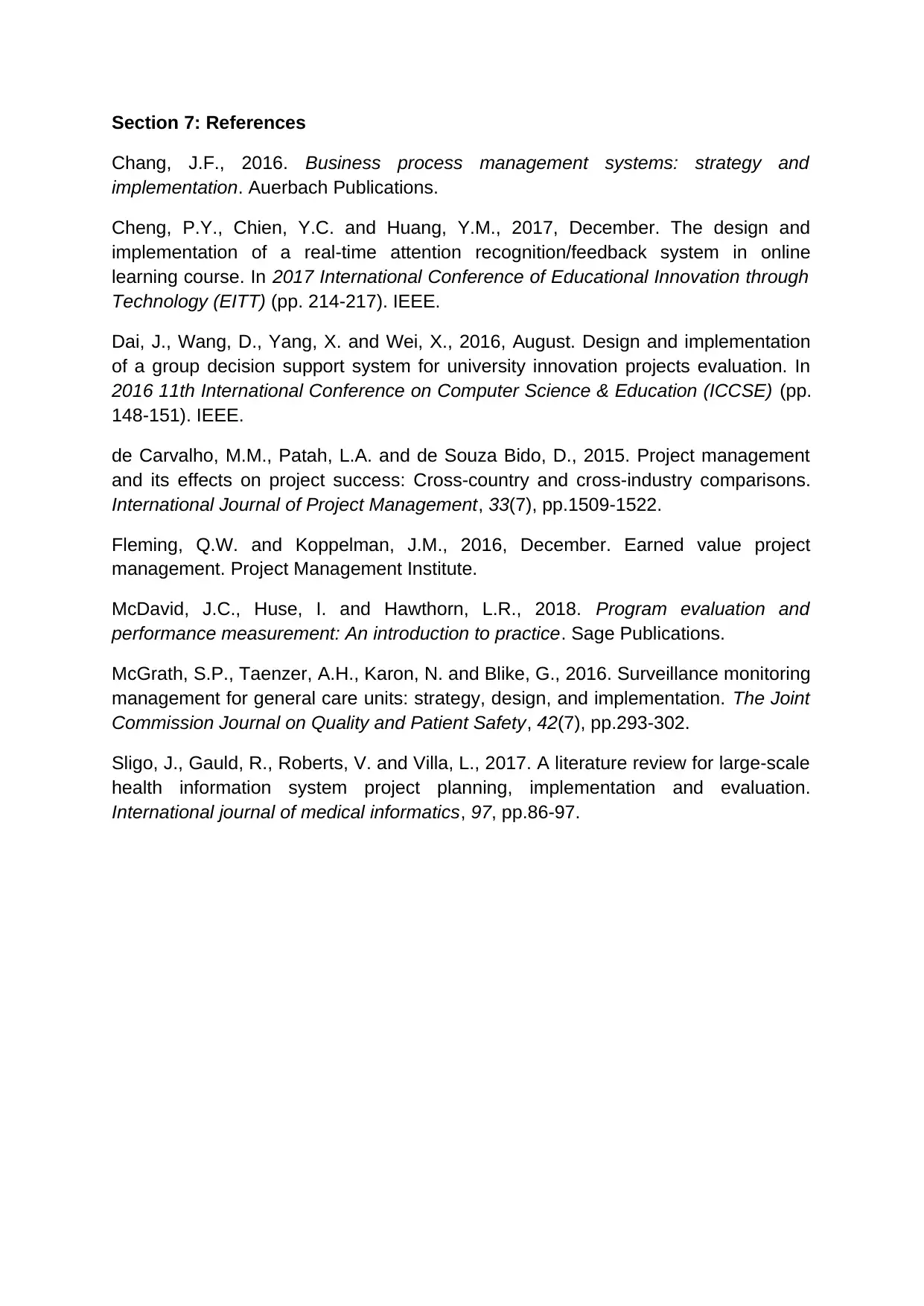
Section 7: References
Chang, J.F., 2016. Business process management systems: strategy and
implementation. Auerbach Publications.
Cheng, P.Y., Chien, Y.C. and Huang, Y.M., 2017, December. The design and
implementation of a real-time attention recognition/feedback system in online
learning course. In 2017 International Conference of Educational Innovation through
Technology (EITT) (pp. 214-217). IEEE.
Dai, J., Wang, D., Yang, X. and Wei, X., 2016, August. Design and implementation
of a group decision support system for university innovation projects evaluation. In
2016 11th International Conference on Computer Science & Education (ICCSE) (pp.
148-151). IEEE.
de Carvalho, M.M., Patah, L.A. and de Souza Bido, D., 2015. Project management
and its effects on project success: Cross-country and cross-industry comparisons.
International Journal of Project Management, 33(7), pp.1509-1522.
Fleming, Q.W. and Koppelman, J.M., 2016, December. Earned value project
management. Project Management Institute.
McDavid, J.C., Huse, I. and Hawthorn, L.R., 2018. Program evaluation and
performance measurement: An introduction to practice. Sage Publications.
McGrath, S.P., Taenzer, A.H., Karon, N. and Blike, G., 2016. Surveillance monitoring
management for general care units: strategy, design, and implementation. The Joint
Commission Journal on Quality and Patient Safety, 42(7), pp.293-302.
Sligo, J., Gauld, R., Roberts, V. and Villa, L., 2017. A literature review for large-scale
health information system project planning, implementation and evaluation.
International journal of medical informatics, 97, pp.86-97.
Chang, J.F., 2016. Business process management systems: strategy and
implementation. Auerbach Publications.
Cheng, P.Y., Chien, Y.C. and Huang, Y.M., 2017, December. The design and
implementation of a real-time attention recognition/feedback system in online
learning course. In 2017 International Conference of Educational Innovation through
Technology (EITT) (pp. 214-217). IEEE.
Dai, J., Wang, D., Yang, X. and Wei, X., 2016, August. Design and implementation
of a group decision support system for university innovation projects evaluation. In
2016 11th International Conference on Computer Science & Education (ICCSE) (pp.
148-151). IEEE.
de Carvalho, M.M., Patah, L.A. and de Souza Bido, D., 2015. Project management
and its effects on project success: Cross-country and cross-industry comparisons.
International Journal of Project Management, 33(7), pp.1509-1522.
Fleming, Q.W. and Koppelman, J.M., 2016, December. Earned value project
management. Project Management Institute.
McDavid, J.C., Huse, I. and Hawthorn, L.R., 2018. Program evaluation and
performance measurement: An introduction to practice. Sage Publications.
McGrath, S.P., Taenzer, A.H., Karon, N. and Blike, G., 2016. Surveillance monitoring
management for general care units: strategy, design, and implementation. The Joint
Commission Journal on Quality and Patient Safety, 42(7), pp.293-302.
Sligo, J., Gauld, R., Roberts, V. and Villa, L., 2017. A literature review for large-scale
health information system project planning, implementation and evaluation.
International journal of medical informatics, 97, pp.86-97.
Paraphrase This Document
Need a fresh take? Get an instant paraphrase of this document with our AI Paraphraser
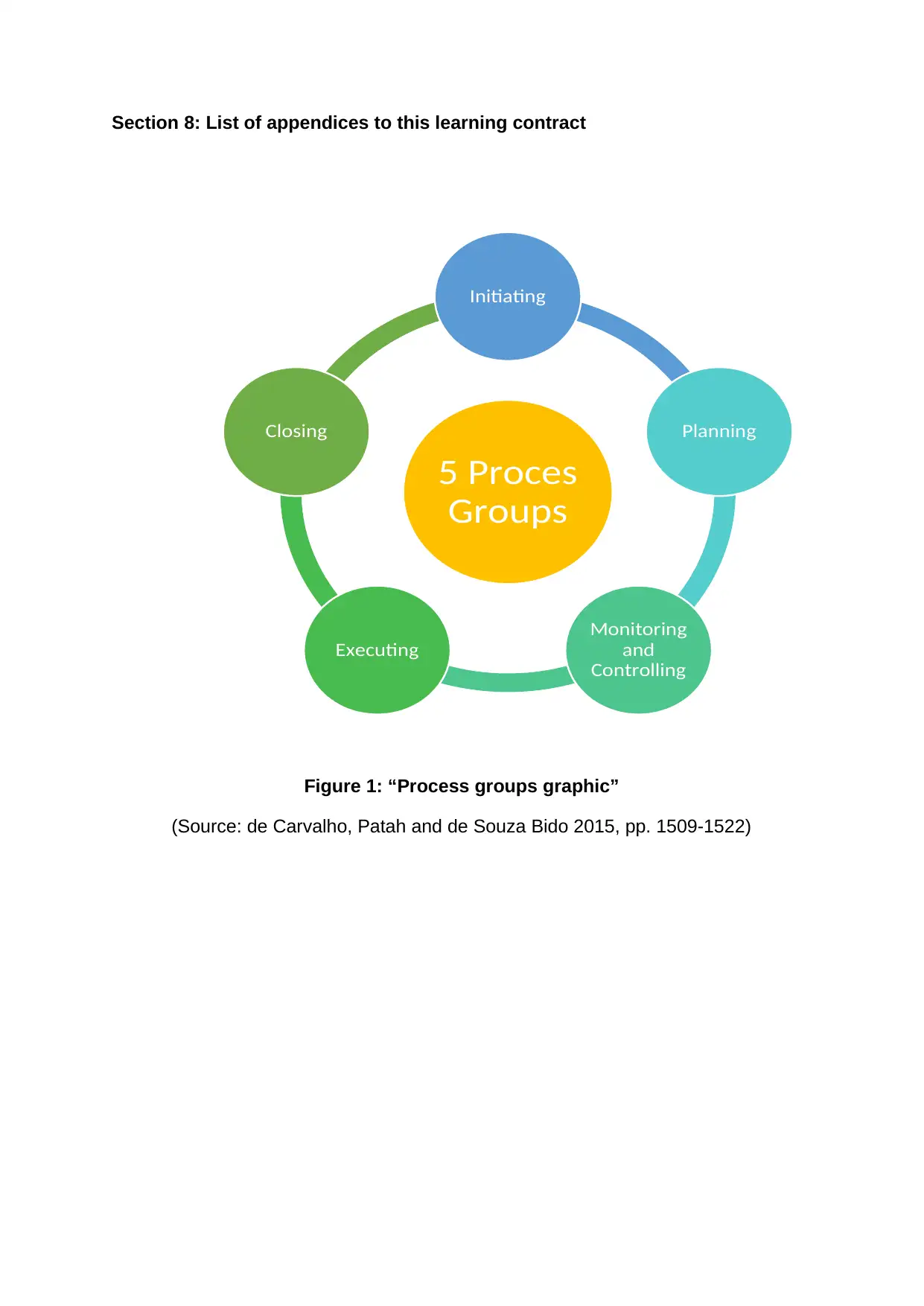
Section 8: List of appendices to this learning contract
Figure 1: “Process groups graphic”
(Source: de Carvalho, Patah and de Souza Bido 2015, pp. 1509-1522)
5 Proces
Groups
Initiating
Planning
Monitoring
and
Controlling
Executing
Closing
Figure 1: “Process groups graphic”
(Source: de Carvalho, Patah and de Souza Bido 2015, pp. 1509-1522)
5 Proces
Groups
Initiating
Planning
Monitoring
and
Controlling
Executing
Closing
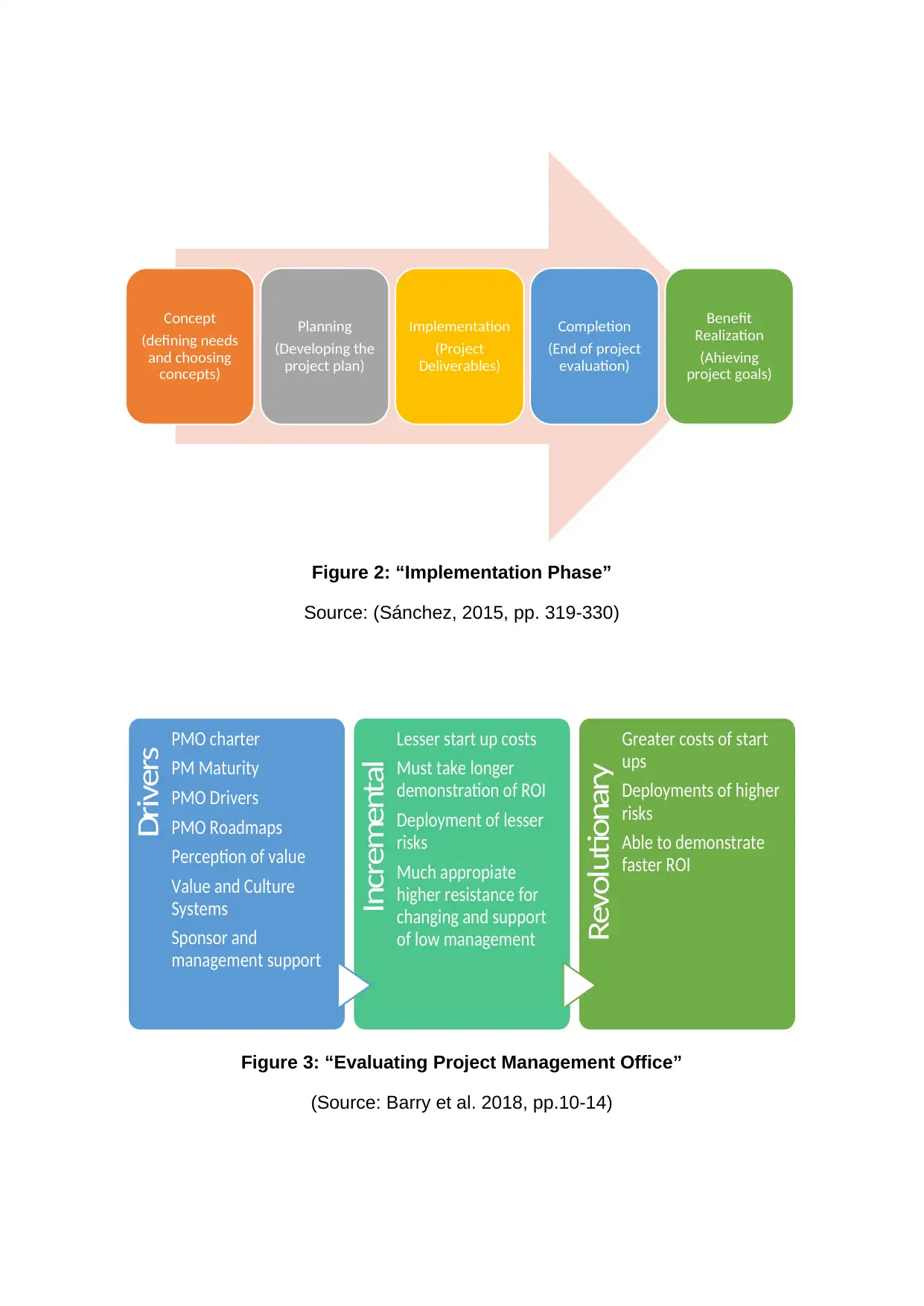
Figure 2: “Implementation Phase”
Source: (Sánchez, 2015, pp. 319-330)
Figure 3: “Evaluating Project Management Office”
(Source: Barry et al. 2018, pp.10-14)
Concept
(defining needs
and choosing
concepts)
Planning
(Developing the
project plan)
Implementation
(Project
Deliverables)
Completion
(End of project
evaluation)
Benefit
Realization
(Ahieving
project goals)
Drivers PMO charter
PM Maturity
PMO Drivers
PMO Roadmaps
Perception of value
Value and Culture
Systems
Sponsor and
management support
Incremental Lesser start up costs
Must take longer
demonstration of ROI
Deployment of lesser
risks
Much appropiate
higher resistance for
changing and support
of low management
Revolutionary Greater costs of start
ups
Deployments of higher
risks
Able to demonstrate
faster ROI
Source: (Sánchez, 2015, pp. 319-330)
Figure 3: “Evaluating Project Management Office”
(Source: Barry et al. 2018, pp.10-14)
Concept
(defining needs
and choosing
concepts)
Planning
(Developing the
project plan)
Implementation
(Project
Deliverables)
Completion
(End of project
evaluation)
Benefit
Realization
(Ahieving
project goals)
Drivers PMO charter
PM Maturity
PMO Drivers
PMO Roadmaps
Perception of value
Value and Culture
Systems
Sponsor and
management support
Incremental Lesser start up costs
Must take longer
demonstration of ROI
Deployment of lesser
risks
Much appropiate
higher resistance for
changing and support
of low management
Revolutionary Greater costs of start
ups
Deployments of higher
risks
Able to demonstrate
faster ROI
⊘ This is a preview!⊘
Do you want full access?
Subscribe today to unlock all pages.

Trusted by 1+ million students worldwide
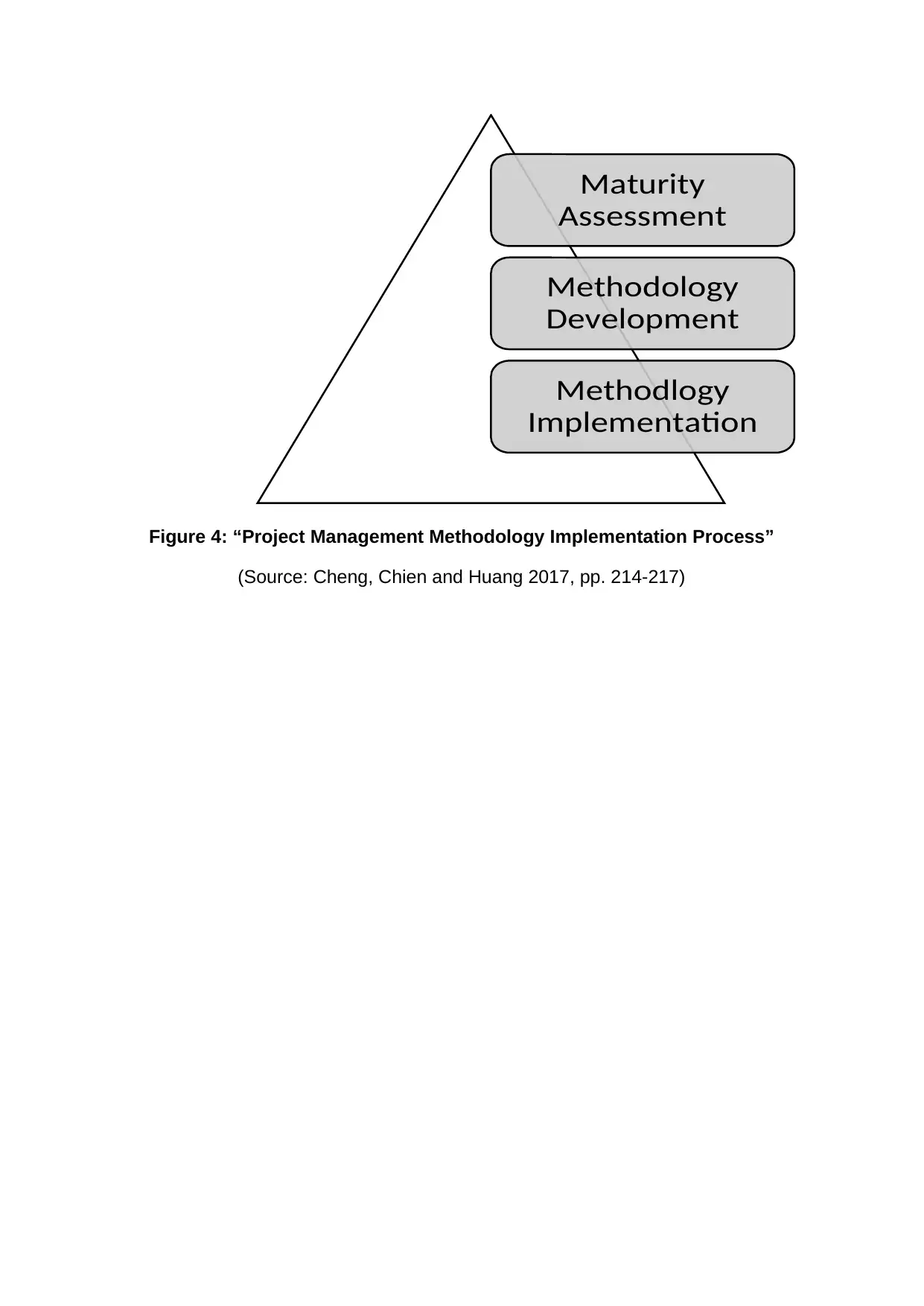
Figure 4: “Project Management Methodology Implementation Process”
(Source: Cheng, Chien and Huang 2017, pp. 214-217)
Maturity
Assessment
Methodology
Development
Methodlogy
Implementation
(Source: Cheng, Chien and Huang 2017, pp. 214-217)
Maturity
Assessment
Methodology
Development
Methodlogy
Implementation
Paraphrase This Document
Need a fresh take? Get an instant paraphrase of this document with our AI Paraphraser
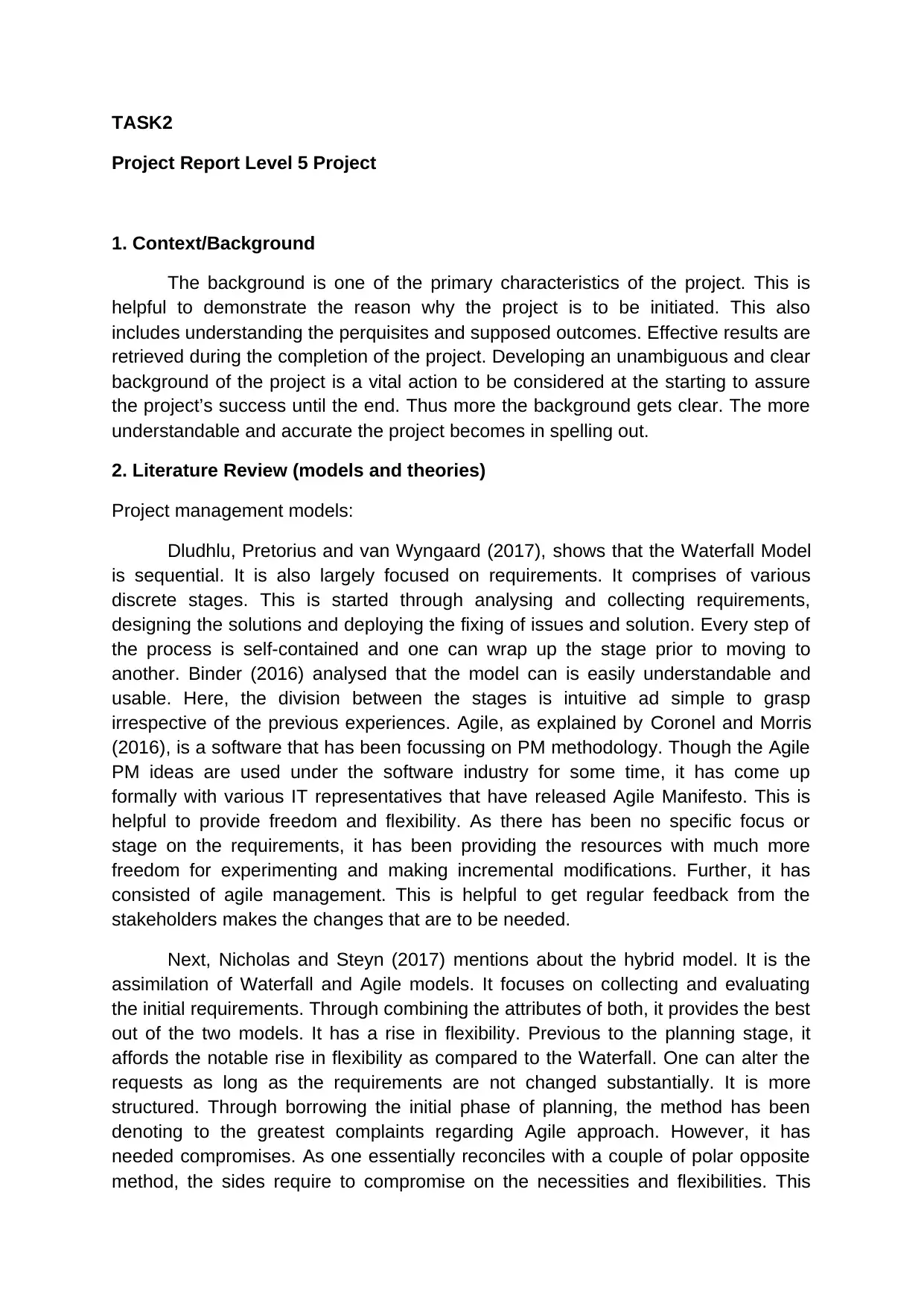
TASK2
Project Report Level 5 Project
1. Context/Background
The background is one of the primary characteristics of the project. This is
helpful to demonstrate the reason why the project is to be initiated. This also
includes understanding the perquisites and supposed outcomes. Effective results are
retrieved during the completion of the project. Developing an unambiguous and clear
background of the project is a vital action to be considered at the starting to assure
the project’s success until the end. Thus more the background gets clear. The more
understandable and accurate the project becomes in spelling out.
2. Literature Review (models and theories)
Project management models:
Dludhlu, Pretorius and van Wyngaard (2017), shows that the Waterfall Model
is sequential. It is also largely focused on requirements. It comprises of various
discrete stages. This is started through analysing and collecting requirements,
designing the solutions and deploying the fixing of issues and solution. Every step of
the process is self-contained and one can wrap up the stage prior to moving to
another. Binder (2016) analysed that the model can is easily understandable and
usable. Here, the division between the stages is intuitive ad simple to grasp
irrespective of the previous experiences. Agile, as explained by Coronel and Morris
(2016), is a software that has been focussing on PM methodology. Though the Agile
PM ideas are used under the software industry for some time, it has come up
formally with various IT representatives that have released Agile Manifesto. This is
helpful to provide freedom and flexibility. As there has been no specific focus or
stage on the requirements, it has been providing the resources with much more
freedom for experimenting and making incremental modifications. Further, it has
consisted of agile management. This is helpful to get regular feedback from the
stakeholders makes the changes that are to be needed.
Next, Nicholas and Steyn (2017) mentions about the hybrid model. It is the
assimilation of Waterfall and Agile models. It focuses on collecting and evaluating
the initial requirements. Through combining the attributes of both, it provides the best
out of the two models. It has a rise in flexibility. Previous to the planning stage, it
affords the notable rise in flexibility as compared to the Waterfall. One can alter the
requests as long as the requirements are not changed substantially. It is more
structured. Through borrowing the initial phase of planning, the method has been
denoting to the greatest complaints regarding Agile approach. However, it has
needed compromises. As one essentially reconciles with a couple of polar opposite
method, the sides require to compromise on the necessities and flexibilities. This
Project Report Level 5 Project
1. Context/Background
The background is one of the primary characteristics of the project. This is
helpful to demonstrate the reason why the project is to be initiated. This also
includes understanding the perquisites and supposed outcomes. Effective results are
retrieved during the completion of the project. Developing an unambiguous and clear
background of the project is a vital action to be considered at the starting to assure
the project’s success until the end. Thus more the background gets clear. The more
understandable and accurate the project becomes in spelling out.
2. Literature Review (models and theories)
Project management models:
Dludhlu, Pretorius and van Wyngaard (2017), shows that the Waterfall Model
is sequential. It is also largely focused on requirements. It comprises of various
discrete stages. This is started through analysing and collecting requirements,
designing the solutions and deploying the fixing of issues and solution. Every step of
the process is self-contained and one can wrap up the stage prior to moving to
another. Binder (2016) analysed that the model can is easily understandable and
usable. Here, the division between the stages is intuitive ad simple to grasp
irrespective of the previous experiences. Agile, as explained by Coronel and Morris
(2016), is a software that has been focussing on PM methodology. Though the Agile
PM ideas are used under the software industry for some time, it has come up
formally with various IT representatives that have released Agile Manifesto. This is
helpful to provide freedom and flexibility. As there has been no specific focus or
stage on the requirements, it has been providing the resources with much more
freedom for experimenting and making incremental modifications. Further, it has
consisted of agile management. This is helpful to get regular feedback from the
stakeholders makes the changes that are to be needed.
Next, Nicholas and Steyn (2017) mentions about the hybrid model. It is the
assimilation of Waterfall and Agile models. It focuses on collecting and evaluating
the initial requirements. Through combining the attributes of both, it provides the best
out of the two models. It has a rise in flexibility. Previous to the planning stage, it
affords the notable rise in flexibility as compared to the Waterfall. One can alter the
requests as long as the requirements are not changed substantially. It is more
structured. Through borrowing the initial phase of planning, the method has been
denoting to the greatest complaints regarding Agile approach. However, it has
needed compromises. As one essentially reconciles with a couple of polar opposite
method, the sides require to compromise on the necessities and flexibilities. This
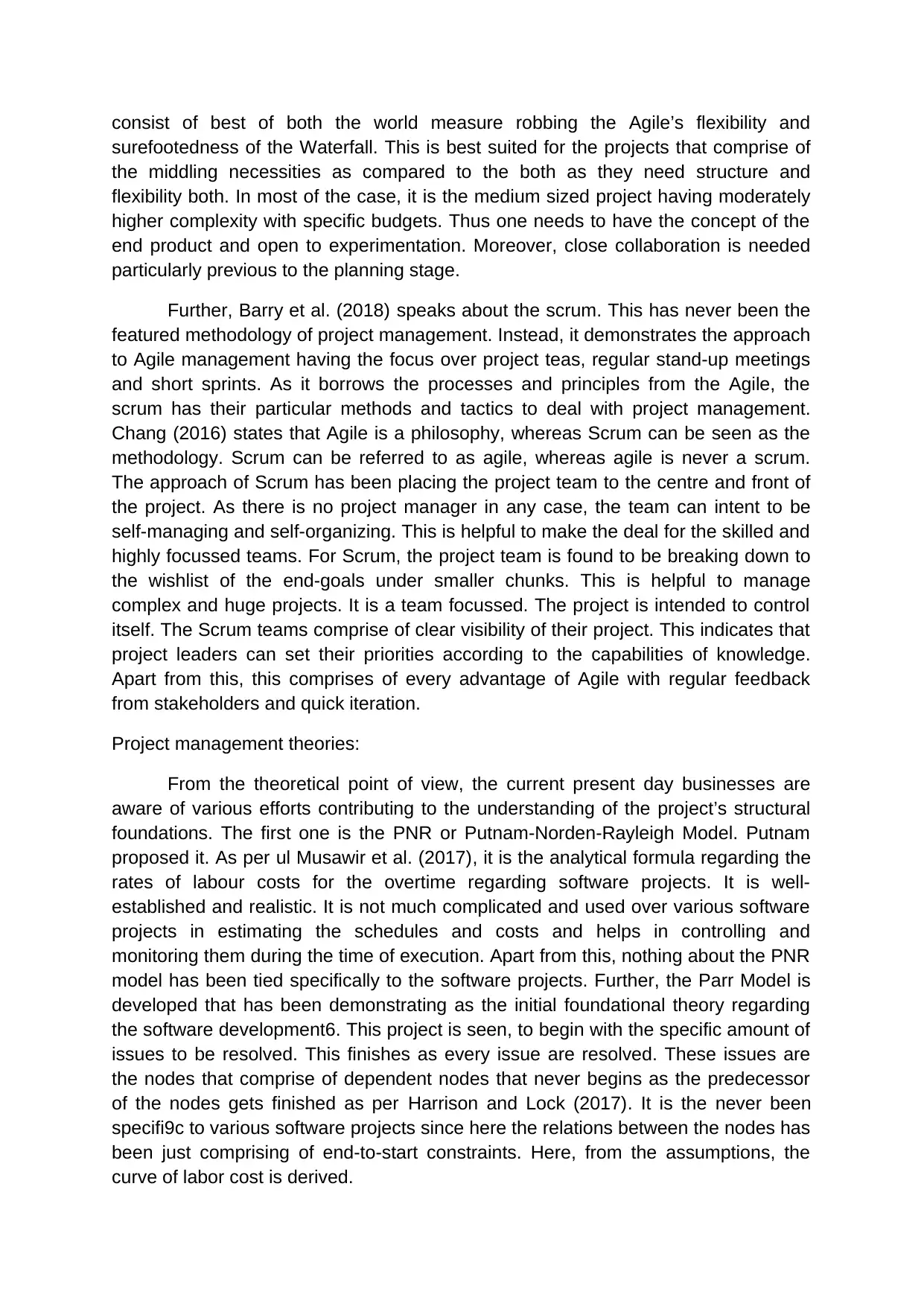
consist of best of both the world measure robbing the Agile’s flexibility and
surefootedness of the Waterfall. This is best suited for the projects that comprise of
the middling necessities as compared to the both as they need structure and
flexibility both. In most of the case, it is the medium sized project having moderately
higher complexity with specific budgets. Thus one needs to have the concept of the
end product and open to experimentation. Moreover, close collaboration is needed
particularly previous to the planning stage.
Further, Barry et al. (2018) speaks about the scrum. This has never been the
featured methodology of project management. Instead, it demonstrates the approach
to Agile management having the focus over project teas, regular stand-up meetings
and short sprints. As it borrows the processes and principles from the Agile, the
scrum has their particular methods and tactics to deal with project management.
Chang (2016) states that Agile is a philosophy, whereas Scrum can be seen as the
methodology. Scrum can be referred to as agile, whereas agile is never a scrum.
The approach of Scrum has been placing the project team to the centre and front of
the project. As there is no project manager in any case, the team can intent to be
self-managing and self-organizing. This is helpful to make the deal for the skilled and
highly focussed teams. For Scrum, the project team is found to be breaking down to
the wishlist of the end-goals under smaller chunks. This is helpful to manage
complex and huge projects. It is a team focussed. The project is intended to control
itself. The Scrum teams comprise of clear visibility of their project. This indicates that
project leaders can set their priorities according to the capabilities of knowledge.
Apart from this, this comprises of every advantage of Agile with regular feedback
from stakeholders and quick iteration.
Project management theories:
From the theoretical point of view, the current present day businesses are
aware of various efforts contributing to the understanding of the project’s structural
foundations. The first one is the PNR or Putnam-Norden-Rayleigh Model. Putnam
proposed it. As per ul Musawir et al. (2017), it is the analytical formula regarding the
rates of labour costs for the overtime regarding software projects. It is well-
established and realistic. It is not much complicated and used over various software
projects in estimating the schedules and costs and helps in controlling and
monitoring them during the time of execution. Apart from this, nothing about the PNR
model has been tied specifically to the software projects. Further, the Parr Model is
developed that has been demonstrating as the initial foundational theory regarding
the software development6. This project is seen, to begin with the specific amount of
issues to be resolved. This finishes as every issue are resolved. These issues are
the nodes that comprise of dependent nodes that never begins as the predecessor
of the nodes gets finished as per Harrison and Lock (2017). It is the never been
specifi9c to various software projects since here the relations between the nodes has
been just comprising of end-to-start constraints. Here, from the assumptions, the
curve of labor cost is derived.
surefootedness of the Waterfall. This is best suited for the projects that comprise of
the middling necessities as compared to the both as they need structure and
flexibility both. In most of the case, it is the medium sized project having moderately
higher complexity with specific budgets. Thus one needs to have the concept of the
end product and open to experimentation. Moreover, close collaboration is needed
particularly previous to the planning stage.
Further, Barry et al. (2018) speaks about the scrum. This has never been the
featured methodology of project management. Instead, it demonstrates the approach
to Agile management having the focus over project teas, regular stand-up meetings
and short sprints. As it borrows the processes and principles from the Agile, the
scrum has their particular methods and tactics to deal with project management.
Chang (2016) states that Agile is a philosophy, whereas Scrum can be seen as the
methodology. Scrum can be referred to as agile, whereas agile is never a scrum.
The approach of Scrum has been placing the project team to the centre and front of
the project. As there is no project manager in any case, the team can intent to be
self-managing and self-organizing. This is helpful to make the deal for the skilled and
highly focussed teams. For Scrum, the project team is found to be breaking down to
the wishlist of the end-goals under smaller chunks. This is helpful to manage
complex and huge projects. It is a team focussed. The project is intended to control
itself. The Scrum teams comprise of clear visibility of their project. This indicates that
project leaders can set their priorities according to the capabilities of knowledge.
Apart from this, this comprises of every advantage of Agile with regular feedback
from stakeholders and quick iteration.
Project management theories:
From the theoretical point of view, the current present day businesses are
aware of various efforts contributing to the understanding of the project’s structural
foundations. The first one is the PNR or Putnam-Norden-Rayleigh Model. Putnam
proposed it. As per ul Musawir et al. (2017), it is the analytical formula regarding the
rates of labour costs for the overtime regarding software projects. It is well-
established and realistic. It is not much complicated and used over various software
projects in estimating the schedules and costs and helps in controlling and
monitoring them during the time of execution. Apart from this, nothing about the PNR
model has been tied specifically to the software projects. Further, the Parr Model is
developed that has been demonstrating as the initial foundational theory regarding
the software development6. This project is seen, to begin with the specific amount of
issues to be resolved. This finishes as every issue are resolved. These issues are
the nodes that comprise of dependent nodes that never begins as the predecessor
of the nodes gets finished as per Harrison and Lock (2017). It is the never been
specifi9c to various software projects since here the relations between the nodes has
been just comprising of end-to-start constraints. Here, from the assumptions, the
curve of labor cost is derived.
⊘ This is a preview!⊘
Do you want full access?
Subscribe today to unlock all pages.

Trusted by 1+ million students worldwide
1 out of 16
Related Documents
Your All-in-One AI-Powered Toolkit for Academic Success.
+13062052269
info@desklib.com
Available 24*7 on WhatsApp / Email
![[object Object]](/_next/static/media/star-bottom.7253800d.svg)
Unlock your academic potential
Copyright © 2020–2025 A2Z Services. All Rights Reserved. Developed and managed by ZUCOL.





